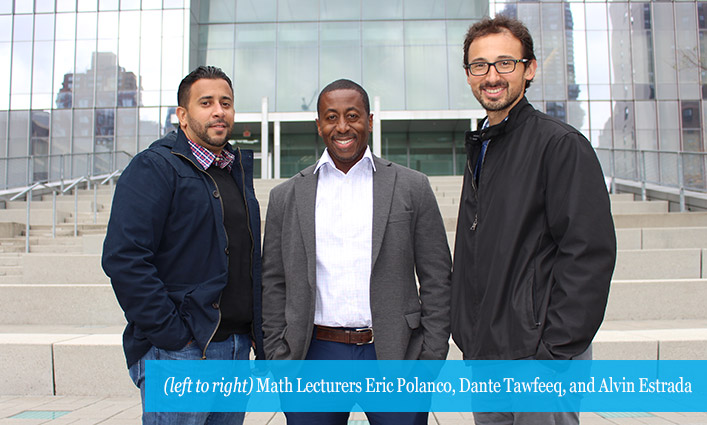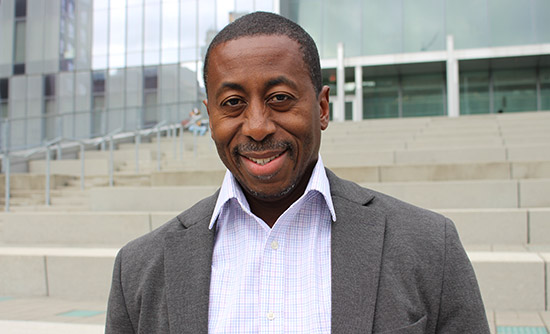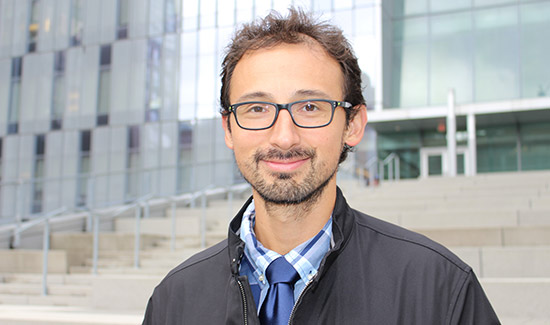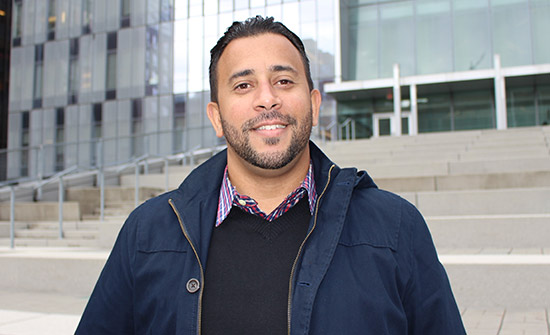
Dante Tawfeeq, Ph.D., Associate Professor in the Department of Mathematics and Computer Science, and Director of the Math Foundations and Quantitative Reasoning (MFQR) Program, has witnessed firsthand the challenges students face when math skills haven’t been acquired or developed, and mathematical anxiety sets in. While working at a number of universities where students had trouble acclimating to college-level work, he played an integral role in reimagining a curriculum that would facilitate learning. At the public high school level, where students shied away from advanced math courses, he increased the number of students taking courses like Advanced Placement (AP) Calculus. And at John Jay College, where a large percentage of first-time freshmen were failing gateway math courses, he helped establish the MFQR Program and successfully led a group of lecturers and faculty, in making math digestible, enjoyable, and one of the College’s most successful gateway curriculums.
“When I saw the article on CUNY’s Math problem, I knew I could fix it.” —Dante Tawfeeq
“I remember reading a story about the large percentage of students failing remedial math courses across the City University of New York [CUNY] system,” Tawfeeq says, explaining what drew him to John Jay. “One of my areas of research is on black and Latinx students’ transition from secondary, or high school learning of mathematics, to post-secondary, or college-level learning of mathematics. When I saw the article on CUNY’s Math problem, I knew I could fix it.” Looking at the data from 2009, only 59 percent of first-time freshmen at John Jay were passing gateway math courses. With the MFQR program and under Tawfeeq’s leadership, this number is currently up to 87.9 percent, making John Jay the number one CUNY senior college for first-time freshmen passing gateway math courses.

Implementing Change in Curriculum
When Tawfeeq came to John Jay, his first order of business was to look at the Math curriculum, and highlight the problems that were leading to students failing the courses. “In my first year at John Jay, I met a student who took College Algebra three times before she was able to graduate,” says Tawfeeq. “Math was the only thing that was holding her back, and that’s not uncommon. The fact was that at the time, individuals in the department didn’t see this as a problem, and when you can’t see a problem, you won’t make the proper adjustments to fix it. So, when I came on board, I registered it as a problem and we have, throughout the years, been able to make adjustments at every turn.”
“Creating stability across the department leads to a downstream effect because students can come together and form these informal study groups across the campus, allowing first-time freshmen to work together and be more successful.” —Dante Tawfeeq
Where previously there were multiple syllabi, differing instructional and assessment philosophies, and non-unified grading scales in place, Tawfeeq sought to unify the curriculum and create stability across the department. By implementing strategies such as pacing and recitation to allow for mastering of processes; making sure lecturers teaching gateway courses follow similar curriculum paths; and creating standard department exams and syllabus, student success increased. “Creating stability across the department leads to a downstream effect because students can come together and form these informal study groups across the campus, allowing first-time freshmen to work together and be more successful,” he says. For additional help, students have access to a number of resources including the Math & Science Resource Center as well as online tutorial videos, created by Adrian Lovell, a lecturer in the department. The videos enable students to see step-by-step instructions on how to solve a problem, while they learn how to compute, check, and interpret data. And, in 2016, the department began using the artificial intelligent assessment tool ALEKS, short for Assessment and Learning in Knowledge Spaces, for after class engagement and homework. Students using the program take an initial knowledge test and, depending on how they answer questions, ALEKS adapts and shapes the homework around the students’ personalized needs—acting almost like an Individualized Education Program (IEP) for students.

Connecting with Students
While those implementations proved fruitful, Tawfeeq credits the change in the approach to teaching as having the greatest impact. “Teaching is an art of diplomacy in my opinion. It takes the ability to communicate clearly and effectively with students in multiple ways, and shifting your engagement in terms of your discourse with your students.” The goal is to make professors more approachable and engaging. To that end, Tawfeeq starts each semester reading a poem to his students. “The poem lets them see that I’m just like them. And, that’s important because students often see mathematicians as being infallible and separate from them. So, by reciting this poem, that’s filled with vernacular they use, students and I connect. They want to be able to come to you and say ‘Hey, professor, I don’t get it,’ and with that connection, they’re more likely to do so.”
“When students see us as normal, regular people, they feel more comfortable and that leads to greater engagement in the coursework.” —Alvin Estrada
Alvin Estrada, Lecturer of Mathematics and Assistant Deputy Director of the MFQR Program, knows Tawfeeq’s approach of “realness” works because Tawfeeq was his advisor during his graduate studies. “I remember thinking, ‘Wow, this guy is so real. He’s straightforward and able to relate math to the real world,’ and that’s rare,” says Estrada, who has taken a similar approach in the classroom. “When students see us as normal, regular people, they feel more comfortable and that leads to greater engagement in the coursework. I had a student come up to me after class one day and say, ‘I never had an instructor teach with so much enthusiasm,’ and that’s a compliment because it shows the student is paying attention, and my delivery of the content is playing a big role in that.”

Changing Mindsets
The final piece to reimagining math at John Jay, Tawfeeq says, was to change the students’ mindsets. “We’ve all stressed to our students, ‘Your grade doesn’t tell you who you are, it just tells you where you are on a learning continuum.’ So if a student comes in and they got Ds, and they think that grade is reflective of who they are, then that’s a mindset we have to change,” says Tawfeeq. “The question we ask ourselves is ‘Can we make the proper adjustments to help you move up to a C, a B, or even an A?’” Moving students up the grade ladder is dependent on more than getting an answer right, it’s also about their ability to follow the steps and master the essential benchmarks.
“Students can use the skills they’re learning in math class outside in the real world, because what we’re really teaching them is how to approach and manage problems.” —Eric Polanco
“Often times we miss what math is really about. Of course, it’s about the numbers, the symbols, and the answers, but it’s also about the process by which one navigates through a bunch of information, in order to come up with a reasonable explanation of what’s going on,” says Tawfeeq. When students demonstrate their work, if the answer is wrong but the steps they took are right, it indicates they understand the concept. And that’s incredibly important according to Eric Polanco, Lecturer of Mathematics. “We are teaching students not only to be problem solvers but also to think critically,” says Polanco. “Students can use the skills they’re learning in math class outside in the real world, because what we’re really teaching them is how to approach and manage problems.”

“It’s what we do in between the lessons to help support our students that have the greatest impact.” —Dante Tawfeeq
Making a Difference
Implementing strategies is important, but “good Mathematicians know, it’s what we do in between the lessons to help support our students that have the greatest impact,” says Tawfeeq, noting he still receives emails from former students who credit him for changing their outlook on Math and education as a whole. “I can only hope that every student that I have the privilege to teach, academically support, or provide a word of encouragement to, not only learns how to efficiently maneuver through some mathematical tasks, but also how to practice ego-resiliency and self-assurance when they engage life’s problems,” says Tawfeeq. “Because those problems can be more complex to resolve than any problem I assign in a College Algebra course.”



